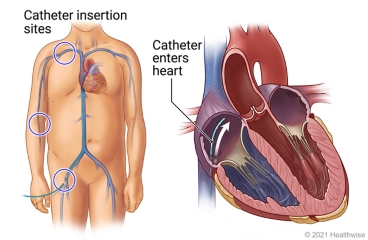Electrophysiology (EP) Study: Before Your Child's Procedure

What is an EP study?
An electrophysiology (EP) study is a test to see if there is a problem with your child's heartbeat (heart rhythm). The test can also find out how to fix the problem. A procedure called catheter ablation is sometimes done at the same time to try to correct the problem.
The doctor puts thin tubes called catheters into blood vessels in your child's groin, arm, or neck. The tubes are guided to your child's heart. There is an electrode at the tip of each tube. The electrode helps the doctor find the problem areas. If a problem can be fixed with ablation, then the doctor uses the electrode to send energy to destroy (ablate) the areas of heart tissue that are causing the problem. The areas that are destroyed are very tiny. They should not affect the heart's ability to do its job.
Your child will get medicines to feel relaxed or to sleep. Medicines also numb the areas where the catheters go in. Your child may feel a little pressure when the catheters go in.
If your child has an EP study only and doesn't need more treatment, they may go home the same day. If your child also has ablation, they may have to stay in the hospital.
How do you prepare for the procedure?
Procedures can be stressful for both your child and you. This information will help you understand what you can expect. And it will help you safely prepare for your child's procedure.
 Preparing for the procedure
Preparing for the procedure
- Talk to your child about the procedure. Tell your child that the procedure will help the heart work as it should. Hospitals know how to take care of children. The staff will do all they can to make it easier for your child.
- Ask if a special tour of the surgery area and hospital is available. This may make your child feel less nervous about what happens.
- Understand exactly what procedure is planned, along with the risks, benefits, and other options.
- Tell the doctor ALL the medicines and natural health products your child takes. Some may increase the risk of problems during the procedure. Your doctor will tell you if your child should stop taking any of them before the procedure and how soon to do it.
- Plan for your child's recovery time. Your child may need more of your time right after the procedure, both for care and for comfort.
What happens on the day of the procedure?
- Follow the instructions exactly about when your child should stop eating and drinking. If you don't, the procedure may be cancelled. If your doctor told you to have your child take his or her medicines on the day of the procedure, have your child take them with only a sip of water.
- Follow the doctor's instructions about when your child should bathe or shower before the procedure. Do not apply lotion or deodorant.
- Your child may brush his or her teeth. But tell your child not to swallow any toothpaste or water.
- Do not let your child wear contact lenses. Bring your child's glasses or contact lens case.
- Be sure your child has something that reminds him or her of home. A special stuffed animal, toy, or blanket may be comforting. For an older child, it might be a book or music.
At the hospital or surgery centre
- A parent or legal guardian must accompany your child.
- Your child will be kept comfortable and safe by the anesthesia provider. Your child may get medicine to bring on a light sleep or to relax him or her. The area being worked on will be numb.
- This procedure can take 2 to 6 hours. In rare cases, it can take longer.
- After the procedure, your child will be taken to the recovery room. As your child wakes up, the recovery staff will monitor his or her condition. The doctor will talk to you about the procedure.
- Pressure will be applied to the area where the catheter was put in the blood vessel. Then the area may be covered with a bandage or a compression device. This will prevent bleeding. Nurses will check the area often.
- If the catheter was put in your child's groin, your child will need to lie still and keep the leg straight for up to a few hours.
- If the catheter was put in your child's neck or arm, your child may be able to sit up right away. If it was in an arm, your child will need to keep the arm still for at least 1 hour.
- Your child may have a bruise or a small lump where the catheter was put in the blood vessel. This is normal and will go away.
When should you call your doctor?
- You have questions or concerns.
- You don't understand how to prepare your child for the procedure.
- Your child becomes ill before the procedure (such as fever, flu, or a cold).
- You need to reschedule or have changed your mind about your child having the procedure.
Where can you learn more?
Go to https://www.healthwise.net/patientEd
Enter E849 in the search box to learn more about "Electrophysiology (EP) Study: Before Your Child's Procedure".
Current as of: July 31, 2024
